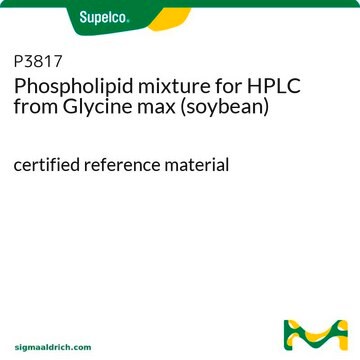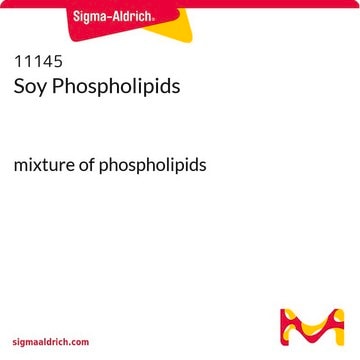If this product has an expiration or retest date, it will be shown on the Certificate of Analysis (COA, CofA). If there is no retest or expiration date listed on the product's COA, we do not have suitable stability data to determine a shelf life. For these products, the only date on the COA will be the release date; a retest, expiration, or use-by-date will not be displayed.
For all products, we recommend handling per defined conditions as printed in our product literature and website product descriptions. We recommend that products should be routinely inspected by customers to ensure they perform as expected.
For products without retest or expiration dates, our standard warranty of 1 year from the date of shipment is applicable.
For more information, please refer to the Product Dating Information document: https://www.sigmaaldrich.com/deepweb/assets/sigmaaldrich/marketing/global/documents/449/386/product-dating-information-mk.pdf
MAK122
Phospholipid Assay Kit
sufficient for 100 colorimetric or fluorometric tests
Synonyme(s) :
Phospholipid Quantification Kit
Sélectionner une taille de conditionnement
502,00 €
Sélectionner une taille de conditionnement
About This Item
502,00 €
Produits recommandés
Utilisation
sufficient for 100 colorimetric or fluorometric tests
Application(s)
cosmetics
food and beverages
pharmaceutical
Méthode de détection
colorimetric
fluorometric
Conditions d'expédition
dry ice
Température de stockage
−20°C
Catégories apparentées
Description générale
In this assay, phospholipids (such as lecithin, lysolecithin and sphingomyelin) are enzymatically hydrolyzed to choline which is determined using choline oxidase and a H2O2-specific dye. This results in a colorimetric (570 nm)/ fluorometric (λex = 530/λem = 585 nm) product directly proportional to the phospholipid concentration in the sample. The range of linear detection is 3 - 200 μM for colorimetric assays and 0.6 - 20 μM for fluorometric assays.
Application
Caractéristiques et avantages
Adéquation
Principe
Mention d'avertissement
Danger
Mentions de danger
Conseils de prudence
Classification des risques
Aquatic Chronic 3 - Resp. Sens. 1
Code de la classe de stockage
10 - Combustible liquids
Faites votre choix parmi les versions les plus récentes :
Certificats d'analyse (COA)
Vous ne trouvez pas la bonne version ?
Si vous avez besoin d'une version particulière, vous pouvez rechercher un certificat spécifique par le numéro de lot.
Déjà en possession de ce produit ?
Retrouvez la documentation relative aux produits que vous avez récemment achetés dans la Bibliothèque de documents.
Les clients ont également consulté
-
How can I determine the shelf life / expiration / retest date of this product?
1 answer-
Helpful?
-
-
How is shipping temperature determined? And how is it related to the product storage temperature?
1 answer-
Products may be shipped at a different temperature than the recommended long-term storage temperature. If the product quality is sensitive to short-term exposure to conditions other than the recommended long-term storage, it will be shipped on wet or dry-ice. If the product quality is NOT affected by short-term exposure to conditions other than the recommended long-term storage, it will be shipped at ambient temperature. As shipping routes are configured for minimum transit times, shipping at ambient temperature helps control shipping costs for our customers. For more information, please refer to the Storage and Transport Conditions document: https://www.sigmaaldrich.com/deepweb/assets/sigmaaldrich/marketing/global/documents/316/622/storage-transport-conditions-mk.pdf
Helpful?
-
-
Is the 10 ml of Assay Buffer in MAK122 sufficient for 100 assays? Also, what amount of sample/buffer should be used?
1 answer-
1. The general recommendation for homogenization is a 1:10 solid to buffer ratio, for example, 20mg solid with 200 uL of Buffer. However, this ratio may not always be optimal. If there are concerns about having enough assay buffer for both homogenization and assays, the homogenization can be run with a different homogenization buffer, provided that it contains at least 0.5% Triton X-100. Please note that the amount of Assay Buffer needed per sample should be enough to yield 40 microliters of supernatant, unless you choose to use your own homogenization buffer with 0.5% Triton X-100.
2. The kit is usually tested on tissue samples. However, it has not been tested on tissues themselves.
3. For homogenizing samples, they can be run through 10-20 passes in a Dounce homogenizer on ice or by sonication, preferably performed in an ice-water bath. The degree of tissue lysis can be checked under a microscope. After homogenization, it is recommended to centrifuge the homogenate at 14,000 g for 10 minutes.
Helpful?
-
-
Why is cold assay buffer listed as a potential cause for the assay not working correctly? Can a 37 or 25 degree water bath be used to thaw the assay buffer? Can the assay buffer be stored at room temperature instead of at -20 degrees?
1 answer-
The troubleshooting bulletin for MAK122 suggests that if the assay does not work, it could be due to the assay buffer not being at room temperature. This is because the enzyme is more active at room temperature than in colder conditions. Although stability data for the assay buffer at room temperature is not available, it is recommended to store it at -20 degrees or evaluate the suitability of room temperature storage. While the composition of the assay buffer is proprietary, it is expected to be stable at room temperature. Additionally, a 37 or 25 degree C water bath can be used to thaw the assay buffer, with a caution against excessive heating and a recommendation to remove it from the water bath once it reaches room temperature.
Helpful?
-
-
To prepare the 0.5% Triton X-100 solution to dilute my samples, should I dilute Triton x-100 in water, in the assay buffer, or something else?
1 answer-
The 0.5% Triton X-100 solution to be used as the sample diluent may be prepared using water.
Helpful?
-
Active Filters
Notre équipe de scientifiques dispose d'une expérience dans tous les secteurs de la recherche, notamment en sciences de la vie, science des matériaux, synthèse chimique, chromatographie, analyse et dans de nombreux autres domaines..
Contacter notre Service technique






